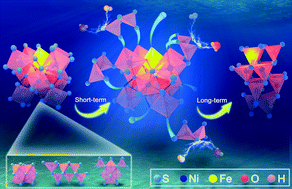Phase reconfiguration of multivalent nickel sulfides in hydrogen evolution†
Abstract
Deciphering the dynamic evolution of a catalyst's atomic and electronic structure under operating conditions is pivotal for unraveling the activity origin and improving catalyst design. Earth-abundant transition metal catalysts have shown efficient catalytic efficiency and are attractive due to sustainable and economic considerations. However, the dynamic evolution process during their whole service time remains elusive, which is greatly complicated by the multiple component and valence states as well as the structural complexity of materials. Here in this work, we investigated the atomic-scale evolution of multivalent nickel-based sulfides (from NiS2 to α-NiS, β-NiS and Ni3S4) as model catalysts for the hydrogen evolution reaction (HER), via operando Raman and X-ray absorption spectroscopies corroborated by theoretical calculations. Dynamic reconstruction propagating from surface to bulk, mediated by sulphur vacancy, has been demonstrated for these materials, all with the terminated Ni3S2 phase on the catalyst surface being responsible for subsequent catalysis. Partial Fe substitution prompts this reconfiguration process and hence improves the HER performance, and therefore establishes the dynamic working mechanism of the widely-adopted doping strategy. We unprecedentedly reveal the dynamic reconstruction with the lower valence state tendency of transition metals in the catalytically terminated phase during the HER, and the life-time dynamic correlation between structure and activity, providing insights into future catalyst design.

- This article is part of the themed collection: Energy & Environmental Science Recent HOT Articles


 Please wait while we load your content...
Please wait while we load your content...